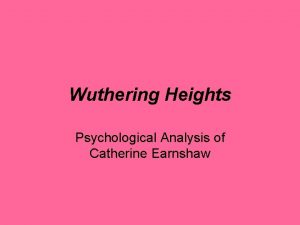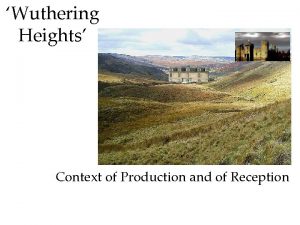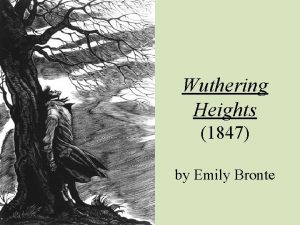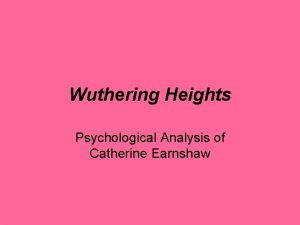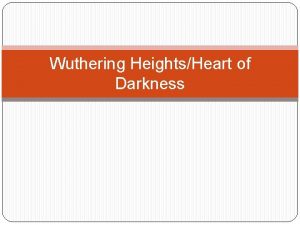Wuthering Heights Psychological Analysis of Catherine Earnshaw If









- Slides: 9

Wuthering Heights Psychological Analysis of Catherine Earnshaw

• If we view WH as a novel of two halves, we can focus on the dialectic between Catherine Earnshaw and Catherine Linton Heathcliff Earnshaw. It is a woman’s struggle with herself; it traces her maturation from girl to woman. The novel is the dialectic between the girl’s infatuation with mythologized romantic love in all its seductive, destructive potential and the woman’s rejection of this myth.

Freud

• Catherine Earnshaw’s maturation resembles the development of the personality described by Freud. The intense symbiosis of Catherine, Heathcliff, and Edgar Linton suggests an interaction within the personality of the ego, id, and superego respectively.

• Heathcliff – id personified • Catherine – ego; as a female, reality offers her few choices • Edgar Linton – superego; consummately civilized

• This personality begins with Catherine Earnshaw and ends with Catherine Linton Heathcliff Earnshaw, or a character who has incorporated and reconciled those elements represented by Edgar (superego) and Heathcliff (id). When the id is frustrated in the attainment of its desires, the ego provides substitutions. What Catherine the elder cannot achieve – freedom from tension, reconciliation of the opposing forces in her nature – is finally achieved by young Cathy.

Jungian Analysis

Shadow • Heathcliff is Catherine’s shadow self – her dark self. • They are the same person: “I am Heathcliff!” • She tries to reject her dark self by marrying Edgar, but the shadow refuses to be repressed: it resists moral control; it stays the same. • The shadow (Heathcliff) must possess Catherine to survive.

Anima / Animus • The animus is the archetype that completes women; it contains the male qualities the persona lacks • To Catherine, Heathcliff is the animus. He expresses anger and hostility, freedom, command, irresponsibility, rebellion, and spontaneity • For Heathcliff, Catherine is beauty, love, status, and belonging.
